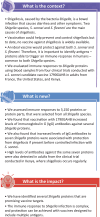Protein-specific immune response elicited by the Shigella sonnei 1790GAHB GMMA-based candidate vaccine in adults with varying exposure to Shigella
- PMID: 40237462
- PMCID: PMC12108075
- DOI: 10.1128/msphere.01057-24
Protein-specific immune response elicited by the Shigella sonnei 1790GAHB GMMA-based candidate vaccine in adults with varying exposure to Shigella
Abstract
Shigella is a leading cause of diarrheal morbidity and mortality in young children from low- and middle-income countries. Here, we aimed to verify the ability of the generalized modules for membrane antigens (GMMA)-based Shigella sonnei candidate vaccine 1790GAHB to elicit an anti-protein antibody response. Serum samples from previous clinical trials in adults (a dose-escalation study and its extension in France, a vaccine efficacy study after human challenge in the United States, and a study in Kenya) were investigated using pan-proteome microarrays consisting of 3,150 full-length or fragmented Shigella proteins. Pre-/post-vaccination comparisons identified subsets of proteins that were highly immunoreactive and largely overlapped across all trials; the T3SS lipochaperone family protein (expressed on GMMA) was the most reactive in all studies. Responses to several microarray antigens correlated well with S. sonnei LPS serum IgG antibody levels. Overall, we confirmed the ability of GMMA to elicit an anti-protein IgG/IgA response; however, no association with protection against shigellosis was identified. In the challenge study, IgG response to seven antigens (IpaC, IpaB, IpaA, IpaD, IpaH, IpgC, and MxiD; not expressed on GMMA) was associated with a decreased risk of shigellosis. These antigens were observed to also have high IgG responses at baseline in individuals naturally exposed to Shigella and could constitute targets for future vaccine development.IMPORTANCEShigella remains a major cause of diarrheal disease, especially in children aged under 5 years from low-to-middle-income countries. No vaccine against shigellosis is yet widely available despite the high public health need. An ideal vaccine would provide protection against the most prevalent species, Shigella flexneri and Shigella sonnei; therefore, it could be relevant to identify common antigens. We developed a microarray containing 3,150 full-length or fragmented proteins selected across Shigella species. Sera collected in four clinical trials conducted in three countries of varying endemicity to evaluate a S. sonnei GMMA-based candidate vaccine were tested against these proteins. We identified several Shigella proteins (IpaC, IpaB, IpaA, IpaD, IpaH, IpgC, MxiD) that induced robust antibody response following experimental challenge or natural infection. These proteins correlated with a reduced risk of shigellosis after the S. sonnei challenge. We found no apparent role for anti-GMMA proteins' IgG or IgA response in protection against shigellosis.
Keywords: Generalized Modules for Membrane Antigens (GMMA); Shigella; protein microarray; proteome immune profiling; vaccine.
Conflict of interest statement
V. Conti, U. Nakakana, A. L. Di Pasquale, P. Ferruzzi, A. S. Sciré, E. Marchetti, L. B. Martin, A. Podda, and F. Micoli are/were employed by GSK at the time the study was conducted. V. Conti, U. Nakakana, A. Podda, and F. Micoli hold financial equities in GSK. A. Z. Randall, X. Liang, J. V. Pablo, J. Edgar, A. D. Shandling, J. J. Campo, and A. Yee are employees of Antigen Discovery, Inc. A. Z. Randall, X. Liang, and A. Yee hold shares of Antigen Discovery, Inc. A. Z. Randall, X. Liang, A. A. Teng, J. V. Pablo, J. Edgar, A. D. Shandling, J. J. Campo, A. Yee, and L. B. Martin received grants or contracts from BMGF. X. Liang and J. J. Campo received grants and contracts from NIH. M. Kapulu received support for the analysis through Wellcome and GVGH subawards. R. Frenck, Jr., received grants from GSK for the clinical trial. O. Launay reports a grant from the French Ministry of Health and grants or contracts from Pfizer, Sanofi-Pasteur, GSK, MSD, MD, AstraZeneca, and Johnson & Johnson. L. B. Martin holds patents planned, issued, or pending: WO2016202872-Immunogenic compositions and WO2021074352-Novel vaccine compositions, filed by GSK. The remaining authors declare that the research was conducted in the absence of any commercial or financial relationships that could be constructed as a potential conflict of interest.
Figures



Similar articles
-
Complement-mediated serum bactericidal activity of antibodies elicited by the Shigella sonnei GMMA vaccine in adults from a shigellosis-endemic country: Exploratory analysis of a Phase 2a randomized study.Front Immunol. 2022 Sep 9;13:971866. doi: 10.3389/fimmu.2022.971866. eCollection 2022. Front Immunol. 2022. PMID: 36203568 Free PMC article. Clinical Trial.
-
Safety Profile and Immunologic Responses of a Novel Vaccine Against Shigella sonnei Administered Intramuscularly, Intradermally and Intranasally: Results From Two Parallel Randomized Phase 1 Clinical Studies in Healthy Adult Volunteers in Europe.EBioMedicine. 2017 Aug;22:164-172. doi: 10.1016/j.ebiom.2017.07.013. Epub 2017 Jul 15. EBioMedicine. 2017. PMID: 28735965 Free PMC article. Clinical Trial.
-
A Novel Shigella Proteome Microarray Discriminates Targets of Human Antibody Reactivity following Oral Vaccination and Experimental Challenge.mSphere. 2018 Aug 1;3(4):e00260-18. doi: 10.1128/mSphere.00260-18. mSphere. 2018. PMID: 30068560 Free PMC article.
-
Serum IgG antibodies to Shigella lipopolysaccharide antigens - a correlate of protection against shigellosis.Hum Vaccin Immunother. 2019;15(6):1401-1408. doi: 10.1080/21645515.2019.1606971. Epub 2019 May 9. Hum Vaccin Immunother. 2019. PMID: 31070988 Free PMC article. Review.
-
Inactivated and subunit vaccines to prevent shigellosis.Expert Rev Vaccines. 2009 Dec;8(12):1693-704. doi: 10.1586/erv.09.127. Expert Rev Vaccines. 2009. PMID: 19943764 Review.
References
-
- Centers of Disease Control and Prevention . 2024. CDC Yellow Book 2024 - Shigellosis. Available from: https://wwwnc.cdc.gov/travel/yellowbook/2024/infections-diseases/shigell.... Accessed12 June 2024.
-
- Centers of Disease Control and Prevention . 2024. Signs and symptoms of Shigella infection. Available from: https://www.cdc.gov/shigella/signs-symptoms/?CDC_AAref_Val=https://www.c.... Retrieved 14 October 2024.
-
- Khalil IA, Troeger C, Blacker BF, Rao PC, Brown A, Atherly DE, Brewer TG, Engmann CM, Houpt ER, Kang G, et al. . 2018. Morbidity and mortality due to Shigella and enterotoxigenic Escherichia coli diarrhoea: the Global Burden of Disease Study 1990-2016. Lancet Infect Dis 18:1229–1240. doi:10.1016/S1473-3099(18)30475-4 - DOI - PMC - PubMed
-
- GBD 2016 Diarrhoeal Disease Collaborators . 2018. Estimates of the global, regional, and national morbidity, mortality, and aetiologies of diarrhoea in 195 countries: a systematic analysis for the Global Burden of Disease Study 2016. Lancet Infect Dis 18:1211–1228. doi:10.1016/S1473-3099(18)30362-1 - DOI - PMC - PubMed
MeSH terms
Substances
LinkOut - more resources
Full Text Sources
Miscellaneous

